What is the purpose of the self-touch movements we do at the beginning of Kai Chi Do (during Thich Nhat Hanh’s End of Suffering)? Charles calls these “The Depths”.
I contacted Phyllis Singer, a gifted healer who uses Touch of Chi, to ask her about the value and meaning of these particular movements and their role in self-healing. The result was a half hour interview – You can download it or listen by clicking the audio player in this post.
[audio:https://kaichido.com/wp-content/uploads/2010/12/Interview-with-Phyllis-final-with-volume-adjustments.mp3|titles=The Depths: Interview with Phyllis Singer]Here’s a summary of the The Depths movements:
Preparation to Receive.
1. Prayer hands: Focusing on the Totality, while asking for Spiritual Support.
2. Left Shoulder, Right Ribs: Ridding Excess from the Past, Bringing in Equilibrium & Vision.
3. Left Shoulder, Left Cheekbone: Letting Go of the Past for a Total Renewal.
4. Both Shoulders: Balancing Unloading of Negativity, While Bringing in Benefit.
5. Right Shoulder, Left Ribs: Ridding Excess from the Present, Fostering Equilibrium & Vision.
6. Right Shoulder, Right Cheekbone: So one can Digest Life, while Letting Go of Preconceived Notions.
7. Third Eye, Heart, and 8. Heart and Third Chakra: Strengthening CORE SOURCE ENERGY, Balancing Heaven & Earth to Uplift the experience of Life as Heaven ON Earth.
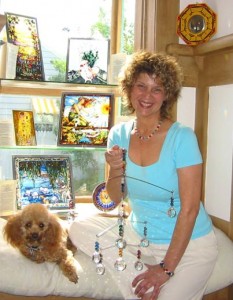
I’ve also included the full transcript of the interview with photos of The Depths movements. Try these self-healing movements on yourself while you listen and feel the energy flowing.
Full transcript of The Depths Interview with Phyllis Singer:
Susan: I am thrilled to be talking with you because, Phyllis Singer, you know that you are one of the people that Charles and I go to when we need “work.” So we’re just really thrilled. You’ve been such a support to us over the years. And in the beginning of Kai Chi Do Charles does some movements that he was inspired to include in the process and really a lot of that inspiration came from the work that we’ve done with you. We’ve never really known what the meaning is, of the different movements, and how they benefit a person. So we wanted to get your viewpoint on that.
Phyllis: Good.
Susan: Please just share a little of your background and how you came to develop Touch of Chi.
Phyllis: I went to college. Became a teacher. Taught emotionally disturbed kids for a couple of years, and found that kind of teaching wasn’t really uplifting to me, as far as being in that kind of system. And in the meantime, found very profound teachers that talked about bodies and bodies energy, and I studied with them, one being Mary Burmeister, another one being Dr. Ida Rolf. And they profoundly affected my viewpoint
of the body and the body’s symptoms, into more of a concept of looking at the body as an energy circulation, as a Life force – and how to work with that circulation. When we have difficulties, there’s stagnation in that circulation, and how to free that up so the body’s wellness mechanism – we all are endowed with a body that has a self-referral mechanism that knows how to balance itself – and this is what I learned from these teachers – to help balance the energy circulation, in some cultures it’s called meridians of the body, to help foster health. In order to have full health this energy circulation needs to be free and unencumbered. And when we have difficulties, usually in thought and attitude or daily abuses in how we live our lives, then that can lead to stagnation which can lead to accumulation which can lead to inflammation, and then we have all kinds of what we call “labels” – things that we call issues in life, different diseases. And from the point of energy circulation, when we get it freed up, the body has a chance to let go of these stress patterns – so it can fulfill it’s harmony. Because the body wants to be harmonized. And it seeks out happy energy. Usually it’s the encumbrances on the energy circulation that makes the experience of life encumbered. So to free that up is very simple. We are all endowed with energy talent. We have a lot of energy or Life Force or Chi – and that’s the word for Life Force in many cultures. And our body and our energy circulation. We have so much energy for our personal life functions that extra energy comes through our hands and feet. And we can actually use our hands, in particular, because it is so convenient, to help apply this impersonal energy that comes through our hands to our personalized functions in our body.
Susan: I love the way you just said that. That’s really beautiful.
Phyllis: Thank you.
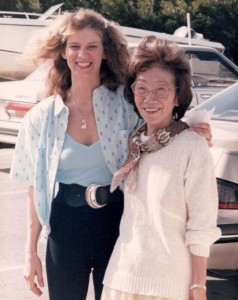
Susan: When we first met – you and I first met – the first session that I had with you was so life changing for me. I just felt like I literally could hear my energy, and it was sort of like dissonant in a way. It was like not running smoothly. And then after you did the session with me – and I think at that time you were calling it Jin Shin Jyutsu or the process that you were using was what you had learned from Mary Burmeister – and I could hear and feel myself all of a sudden come into energy harmony. It was like being in this egg of circulation of energy. And it was so profound. It made such a difference for me, and we went to you – I think practically every week during the pregnancy with Shanti because it made such a difference in how I felt.
Phyllis: It was wonderful to be with you too. And it’s the freeing up of that circulation that brings us to the harmony that is naturally ours, that we forget that we have. And the beauty of it is, I call myself the “industrial strength cleaner”. So I help people who haven’t known they have an energy system to work on, so they have so many years of stagnation. Kind of like having a house and you don’t clean it except to do a dish or two. Well, it usually takes some time and some energy and industrial strength cleaning to get that house in order. My ultimate vision for people is that they stay well with their own hands. That there is an aspect of self-help. That we can foster harmony in our own circulation. Usually when people come to me, they come to me with this house that hasn’t been tended to because they really didn’t even know it existed on a level that it could be affected by the hands. So that’s part of the project that Touch of Chi is to let everyone know that we can have well-being in our own hands. And we first help ourselves. And then we can help others.
Susan: I just love that. I love how every time we come to you for a session, you send us home with a little prescription pad that shows the points on the body that we should hold with our hands for the kind of energy release that we are in need of at the time. It’s just perfect. So I’m just thrilled that we’re going to get to talk about how the self-touch that we do during Kai Chi Do – how you view that from the point of view of Touch of Chi.
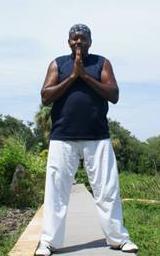
Phyllis: And as I look at the poses that Charles is in, they are very profound – what he is bringing in to help himself and others. The first one I’m seeing are his two hands together in front of him. So the prayer pose is focusing on the totality while asking for spiritual support.
Susan: So, in a sense, it’s focusing and aligning yourself with the spiritual energy.
Phyllis: The spiritual energy. Asking for spiritual support.
Susan: Uh-huh.
Phyllis: Touch of Chi is very simple. Jin Shin Jyutsu is very simple. And when one puts their hands together like that – all the energy flows go through all the fingers and the palms – so when we hold those together, it helps the whole system of the body. And also, holding it at the chest, at the bust line here, where Charles is holding his hands together, is asking for spiritual support.
Susan: It’s so beautiful that that movement – I think it’s in every culture.
Phyllis: Yes.
Susan: When I think around the world, every culture has that movement.
Phyllis: And what that speaks to me is that this “work” is innate to all of us. We find children sucking fingers. Different babies suck different fingers. And you’ll see people in life hold different parts of their body, and they’re actually working on their system without even knowing. It’s innate to all of us. It’s part of our inheritance as people – this energy gift we all have.
Susan: And then what’s the next photo that you see?
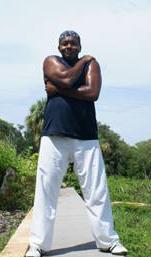
Phyllis: The next photo, Charles has his right hand on his left shoulder and his left hand on the base of the right rib. And that one is ridding excess from the past – bringing in equilibrium and vision.
Susan: What does that mean, “ridding excess of the past”?
Phyllis: What happens is we start accumulating, usually with our thoughts – usually it’s an accumulation of negativity because we fully experience usually the joys in life. Sometimes we don’t, but often we’ll go toward those. Whereas, with negativities we’ll sometimes bury that. And we’ve become like a closet full. I call it a “stack attack”…
Susan: (laughing).
Phyllis: …where we have some kind of upset or attitude or thought about something and we shove it into the closet. And then one day we open that closet door, and all this stuff comes out. And so that’s what I mean of ridding excess – things that we’ve accumulated. If we lived in the present moment and lived it fully, we wouldn’t have this accumulation. And it’s the human challenge to allow oneself to be in this moment and not bring in the past. Because this moment will be the past in the future. And we let go, we let go, we let go, so we can have the inheritance that we have of balance. What happens with the excess, of all this storage of thought, it will start creating stress patterns, stress circles in the body. And that’s when we find circular patterns. We find names for diseases and things like that. Whereas, if we let go of the excess, then the body can take over and renew the harmonized pattern.
Susan: I just love that I’m getting the chance to hear this from you because I love how the movements feel but I’ve never had any way to interpret it. I just have been in feeling it and experiencing it but I never had any way to really understand it. So this is just a thrill for me.
Phyllis: And when I say that people have worked on themselves during their lives and not knowing it, they’ve been helping themselves that way without knowing it too. And there’s probably things that all of us do to help calm ourselves down that we don’t know about. Bringing it to awareness – that’s all this is, is the application of awareness.
Susan: So really being able to utilize these movements deliberately for self-healing.
Phyllis: Exactly. And that letting go of the past is part of that. Ridding excess is part of that. So we can be available to ourselves in the current moment – in this instant.
Susan: What’s the next picture that you see? The next movement?
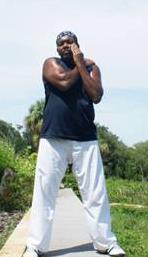
Phyllis: The next picture is…Charles has his left hand on his cheek, and his right hand on his left shoulder.
Susan: And what does that mean, when you have you hand on your shoulder like that and then your hand on your cheek?
Phyllis: The shoulders are letting go. And also holding the face is letting go. Letting go of the past for a total renewal.
Susan: It’s a great way to start Kai Chi Do…
Phyllis: Yes.
Susan:…by letting go of the past (laughing).
Phyllis: It’s totally a beautiful set up. And it get’s better.
Susan: Oh! It gets better! Okay! What’s next?
Phyllis: (laughing) Okay. And then the fourth one, he’s holding, he’s crossing his arms, holding the right hand on the left shoulder and the left hand on the right shoulder. And that’s balancing unloading of negativity, while bringing in benefits. There are all kinds of benefit available for us, but if we are so encumbered with negativity – which is usually an
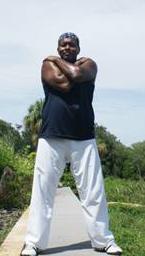
accumulation from the past – we don’t experience and we have difficulty bringing in benefits. So it’s really clearing the slate, so one can renew oneself.
Susan: Yeah. Kind of like giving away all your old clothes so you have room in your closet for the new stuff.
Phyllis: It’s getting rid of the body clutter.
Susan and Phyllis simultaneously: Energy clutter.
Phyllis: Yeah. The same thing. Energy and body – the same thing. Form is formless and formless is form. It’s the same thing. Mary Burmeister used to say, “Spirit is the highest form of matter and matter is the lowest form of spirit.”
Susan: But it’s all one and the same. Just different manifestations.
Phyllis: Yes. And I feel like we get in difficulty in this culture often, because we separate and look at things as pieces and parts. And that’s fine. That’s content. But we forget there’s a context that we live in. And this [Kai Chi Do] is helping context and content. We get really segmented in cultures because we look at things so partially instead of impersonally. And then that’s what helps – the ridding excess, the letting go – helps us see things as they are – not as they were.
Susan: What makes sense to me is how we talk about the mind and the body, or the body and the spirit as if they are separate, and as if you have to do something to bring them together. When in fact, they already are together.
Phyllis and Susan: (laughing)
Susan: So then what Charles does is he actually goes ahead and leads people in reversing the same movements, doing the same movements but on the other side of the body. From your point of view is there a difference in the meaning between one side of the body and the other?

Phyllis: There is. And this is like the second posture – ridding excess from the past. Now this posture rids excess from the present. So the past and present – different sides: Left is past, right is present. That fosters equilibrium and vision.
Susan: And by vision you mean…
Phyllis: Spirit, mind, body vision.
Susan: Everything.
Phyllis: Yes. So if people are looking for a deeper vision of life, this would help. Or if people want to help their physical vision, this would help.
Susan: Beautiful. Charles has looked at the right and left sides of the body as left is receiving and the right is projective or giving. And that balance between giving and receiving. Do you see that too in…?
Phyllis: The palms have that same thrust. In other words, the left pulls, the right pushes. In the Touch of Chi, we can use that directionality of the palms for specific needs.
Susan: I love this. I just really love this.
Phyllis: And how it all matches, isn’t it? It’s wonderful.
Susan: It is. It’s beautiful, and you are so articulate about it. Really. I mean you are able to explain these in such a way that it’s easy to understand, and it all makes sense. And I just really appreciate that about you. I mean it really shows – all the study that you’ve done for these decades. And anybody that’s been on your table knows that your touch is so powerful. It’s not just philosophy. It’s also a tangible experience.
Phyllis: One thing is that everything gets better with self-help. So I have a practice of self-help for myself. And that really is the other side of it for me. And when I’m with clients, that grows me. However, if I weren’t engaged in actually receiving work from others and also the self-help – is so critical, to have that balance. And I’ve found when I had a very active practice that clients would, in a sense, go with my flow. If they weren’t self-helping, then I’d look to myself and neither was I. And when I was, they were. So we have an effect on each other, whether we are aware of it or not. That’s what I got to learn from that. If I wanted others in my life to self-help, I needed to look at myself first. So that’s a real powerful part of it. Because we’re with ourselves at 4 in the morning when somethings goin’ on. We don’t have someone we can call, usually, to come work on us. So to know how to take care of myself is crucial – I feel – for being happy on the planet. With Touch of Chi I want to share this awesome benefit I’ve had – of living most of my life knowing about energy circulation, effecting it, and how we participate. Our individual energy is all connected to the same Source, so we are all connected. And to get to understand that – and that comes in pieces, that understanding – To get out of analysis, into that Knowing that we are all One, and we are all of One Energy. And each one of us is a unique expression of the same Energy. And I would like to help people realize that – for their freedom. They can have the same benefits I’ve had in my life.
Susan: I’m so glad that we found each other.
Phyllis: Me too.
Susan: And our little Shanti – learning how to do Jin Shin on herself or Touch of Chi on herself. And also even sharing it with her friends. I remember when she was in nursery school, she got a little certificate from the nursery school for doing Jin Shin on somebody, on another little girl who had gotten a boo-boo. So that was really cool.
Phyllis: I love that story. That was the best. And that is what makes my soul sing – when the work has gone away from me, out to the ripple effect. Out there in the world. It’s something that all of us have as our inheritance. And my zeal about it is to let people know that this is here. We can use this.
Susan: Can you tell us a little bit too – I keep using on using the words Jin Shin and Touch of Chi interchangably but there is a diffence. Can you share a little bit about that?
Phyllis: I learned Jin Shin Jyutsu in the 70s, and studied with a woman Mary Burmeister that brought it over from Japan. And Mary had learned from a man named Jiro Murai in Japan. And he asked her to take this art to the West and she very flippantly said, “Of course I will”. And she actually spent her life in the United States, bringing forth this art and teaching. So I had the value of studying with her. And as much as studying the meridian systems and the energy flows, also her philosophy of life. And that this work was philosophy first – and this is Jin Shin Jyutsu. Jin means compassionate human. Shin means – this is Japanese – Shin means creator. And Jyutsu means art. So it’s the Creator’s art through compassionate human. Touch of Chi has evolved because I have studied so many things. I’ve studied years of Ayurvedic. I’ve studied years of Feng Shui. I’ve studied rolfing and different types of modalities – so many different ones that I’ve become a unique instrument – in that I don’t decipher now which is Jin Shin Jyutsu and which is…So I’m calling it all Touch of Chi because it has to do with Chi, is Life Force. And I want to help people have a touch of Life Force in their own hands, to realize that we do have Touch of Chi within us. All of us. And once we help ourselves, we can extend that help outward. So the Touch of Chi has become unique to me because I’ve become an instrument who studied with so many variety of, luckily, these awesome masters that I’ve gotten to be with.
Susan: You’ve studied with the best – some of the very first artists in the field.
Phyllis: Yeah. I got to study with Brugh Joy, Deepak Chopra for 6 years – I was one of his first Magic of Healing educators when it was called that – I think it’s called something different. That was Ayurveda. At that moment I was in a very full time Jin Shin Jyutsu practice with clients coming in all day, every day. And I worked with Ayurveda some. And some very sick people came to me, and there was a physician in St. Petersburg and I sent them there because I realized I was only one person and I could only do so much. And studying any of these arts is a lifetime study – any of them. So I have spent my lifetime studying them. Some of them – almost all of them – I feel like I’m just scratching the surface even after 30 some years of study. So, Touch of Chi is a compilation of all the wonderful human Chi I’ve gotten to be around. Because all of us have our personal Chi, our personal Energy, and I’ve gotten to be around people of such magnificent Chi – such as Mary Burmeister, Dr. Rolf, Deepok Chopra, Brugh Joy…and I could keep going.
Susan: Come, let’s come back to “The Depths” in Kai Chi Do, and tell me more of your interpretation of that. So there’s that point where we change and do the same movements on the other side. And then, after that, what Charles does is he has one hand on his third eye [forehead, just between and above the eyebrows] and the other hand by the heart. And what is the meaning of that movement?
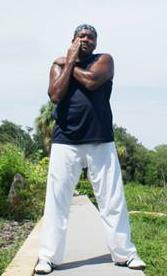
Phyllis: Well, let’s go back to the other one. Given the difference of right and left. And so the opposite, where he is holding his face and the opposite shoulder. You can do that so that one can digest life and while letting go of preconceived notions. Life would be so great if we could treat everybody as brand new every time we meet them. You know, let them be brand new. So we don’t have to pidgeon hole people with our labels – and those are the preconceived notions. And the toll it takes on us is it limits our own consciousness when we are seeing through the filter of preconceived notions. And life is to be digested. Thoughts are to be digested. So this [movement] will help people digest life, digest preconceived notions – all that thought that doesn’t need to be there. So one can free oneself up for the moment, for the instant.
Susan: So where we’ve been up until now in the movements is clearing the past, clearing the present, and being open to experiencing the moment purely – without preconceived notions and just being able to participate in that fully.
Phyllis: Beautifully said.
Susan: Thank you.
Phyllis: So the last ones – with the third eye [on the forehead, between and slightly above the eyebrows] and holding the heart chakra, and then the third chakra [solar plexus] – both of those together are strengthening core Source Energy. And it’s balancing Heaven and Earth – above the waist is Heaven,

below the waist is Earth – to uplift the experience of Life as Heaven on Earth.
Susan: Those two movements really are sort of a pair. The one with the third eye and the heart, and the one with the heart and the third chakra. Those are a pair that…
Phyllis: balances Heaven and Earth. Yes.
Susan: That’s beautiful…
Phyllis: Now it uplifts the experience of Life so it can be like Heaven on Earth. Because really, our inheritance is unbounded bliss. And I think that’s why so many of us are joyous around babies. Because babies haven’t loaded up and, unless they have physical issues, they are unbounded bliss. And that’s our inheritance. And that’s the Heaven on Earth that we are all seeking. We simply haven’t been shown any methods – or many methods – to help ourselves out that way. One of the great things of this current time is these methods are coming through people, such as Charles with the Kai Chi Do – his great instincts to pick these poses, postures, that he has, to begin with. It’s the application of setting the instrument – like in a sense “resetting”. Everybody gets to reset themselves to the moment. We’re freed up – for bliss!
Susan: And that’s really what it feels like too.
Phyllis: Well, it’s wonderful to get to talk about it.
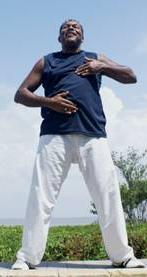
Susan: Really, the whole purpose of Kai Chi Do is to have Spirit circulating freely. And to connect with yourself, and Source, and with other people. It’s all 3 of those connections.
Phyllis: What he does at the beginning sets the stage for that. It makes the instrument free to participate at a level that that can come through. Dr. Rolf developed 10 sessions to balance the body’s structure, and the first session was all about working on the chest and upper body in such a way that it would open to be able to open up the breathing and circulation and to accept all the changes that are coming in. So I feel this is the same kind of thing, where it’s preparation for all this transformation. So, in other words, to have a clean slate to go into this new form.
Susan: When I’m doing the movements, and preparing – the early part, “The Depths” Charles calls it, these early movements before we get into the more rhythmic movements of Kai Chi Do – I just find myself feeling very centered. That’s how it feels to me, is just coming into the present moment and feeling very centered and focused.
Phyllis: Yes, and that’s you being on Earth – really knowing you are here, right now, in this moment.
Susan: I like what you said about it being a way to start with a clean slate. I want to thank you so much for having this conversation with me.
Phyllis: You’re so welcome. It’s been a pleasure. And you and Charles and Shanti have been such a joy in my life, and are such an embodiment of the harmony that all of us could have, when we apply our awareness that way. So I appreciate the example that you are to the rest of us. So we know it’s possible.
Susan: Thank you, Phyllis.
Thanks so much Phyllis for helping to bring form and definition to the Kai Chi Do movement. You are a great inspiration and bright being that has come to uplift us in this new time. We welcome your knowledge of energetic flows which supports the dynamic movement of Chi or life-force.
Many Blessings
Charles
Thank you so much for giving me this opportunity to clearly understand the process better. As Susan commented throughout the interview, I always felt what you were saying. And yes, I am thrilled to have met Phyllis so that she could help to clear out my closet full of stuff!!!!! In addition to doing Kai Chi Do, where I can do this on a daily basis. I have been practicing the self help movements of Jin Shin Jyutsu that Phyllis showed me and I have shared this with my nine year old grandson Jacob (here in Australia) who is doing it daily and says it has really helped him. So thank you Charles and Phyllis!
Much love and many Blessings!! Marty
We love you, Marty! Thanks for taking this work to Australia!
wow, I just finish the interview, how powerful, to have words for the movements and feeling. I also love “Treating everyone as brand new everytime we meet them.” won’t that unravel life’s knickers in a twist sysdrome.
my declaration for today and everyday until it becames habit is to treat everyone as brand new when I meet them.
Thank you so much for this interview, and all you good work
Kim
Thank you so much, Kim! Thank you so much for the love you bring. We’re sending blessings!
Pingback: Spiritual Games for starting a New Year | kaichido.com
Pingback: The Root Element of Kai Chi Do | kaichido.com
Been waiting for something like this . much easier to explain wha kia ch do is all about. Charles is awsome
I never stopped really loving you.